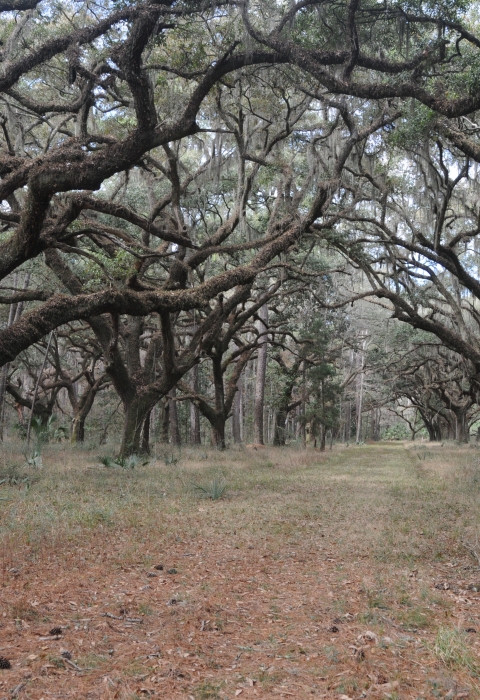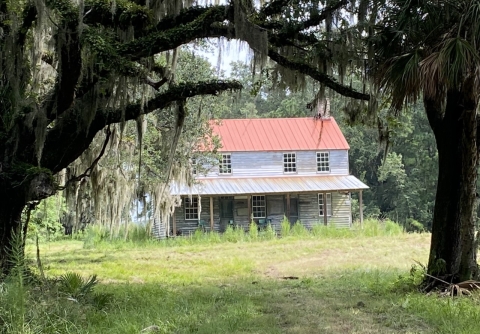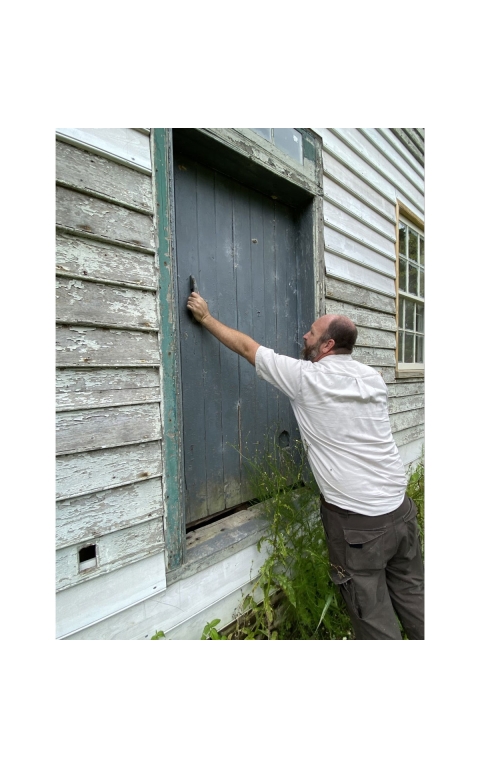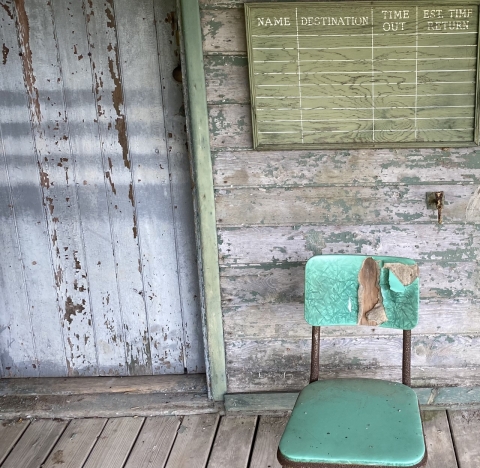Beaufort, South Carolina -- The old plantation on Jehossee Island stands out as an historical gem even in the Lowcountry region where moss-draped carriageways and antebellum manors abound. Ownership of the one-time largest rice plantation in the South passed through the hands of the Draytons and Aikens – South Carolina royalty. Its ramshackle remains are under consideration for a prestigious National Register of Historic Places designation.
Jehossee, surprisingly, is owned by the U.S. Fish and Wildlife Service, an agency not known for historic preservation. It’s part of the nearly 12,000-acre Ernest F. Hollings ACE Basin National Wildlife Refuge. The Service, given its conservation mandate, manages the island primarily for migratory birds, resident marsh birds, raptors, and songbirds.
And that may be the very reason why Jehossee survives to this day. If not for the years-long upkeep of the abandoned rice paddy wetlands as feeding grounds for ducks – and the federal requirement that the Service catalog and maintain historic properties – the plantation might’ve been bulldozed into yet another coastal home-and-golf community.
Instead, a coalition of federal, state, nonprofit, and university groups are researching and restoring portions of Jehossee, beginning with the overseer’s house and the rice mill. Extensive mapping of the overgrown fields, plantation house and slave quarters is next on the list. And, while research into the usual antebellum plantation lifestyle continues apace, historians seek to emphasize the oft-overlooked history of the enslaved Africans who made Jehossee a success, yet rarely get their due.
“We know very little about the lives of the enslaved peoples -- their expertise, their skills, the entire magnitude of their labor and skilled management,” said Antoinette Jackson who first visited the island in 1995 and now chairs the anthropology department at the University of South Florida. “None of that comes through at all in the telling of the history of enslaved African communities. But it’s a fascinating history. We need to utilize this resource, and this moment in time, to tell their story.”
Ducks to the rescue
Brett Craig, the refuge’s acting manager, steered the johnboat toward Jehossee Island. Crab pot buoys bobbed along the Intracoastal Waterway. The South Edisto River wrapped around the island’s western edge. A bridge once connected Jehossee to the mainland. Its disappearance explains why the island looks, from a distance, much as it might have two hundred years ago.
Craig docked and the island unspooled in a Lowcountry patchwork of salt and freshwater ponds, overgrown fields, and hardwood forests. Rice trunks, the water-control sluices imbedded in levees, remain in use. Craig and others at the refuge, continue to operate the trunks to ensure a healthy fresh-salt water mix for a variety of threatened, endangered, and game birds. Black rails. Wood storks. Least bitterns. Bald eagles. Saltmarsh sparrows. Purple gallinules. And plenty of wood ducks, mallards, and green-winged teal.
“What saved the ACE basin, and this is important, is ducks,” said Charles Lane, who owns the nearby Willtown Plantation and helped start started the public-private ACE Basin Task Force in 1989. “Ducks were in bad shape that year. So, the Fish and Wildlife Service was brought in to manage the impoundments and provide sanctuary for waterfowl. We’ve had a huge increase in our wintering waterfowl numbers ever since.”
Lane and others, worried about a Lowcountry covered in condos and golf courses, created the task force with the goal of protecting 90,000 acres across the 1.6-million-acre coastal region that includes the Ashepoo, Combahee and Edisto river watersheds. Today, 320,000 waterfront acres have been conserved, mostly via easements. Jehossee Island accounts for 4,520 acres.
The island’s first white settlers arrived in the late 1600s and, by 1730, rice cultivation had begun. African slaves cleared hundreds of acres of tidal swamps, built levees to create the rice paddies, and crafted the floodgates from tree trunks to manage the mix of fresh and salty waters. The Drayton family, colonial emigrés from Barbados, purchased the island in 1776 and turned Carolina Gold Rice production into a family fortune. Jackson and other scholars surmise that slaves brought swamp-rice cultivation with them from West Africa. U.S. Census Bureau records show that upon Charles Drayton’s death in 1820, there were 40 slaves on Jehossee.
William Aiken Jr. began buying up Jehossee land thirteen years later and, by 1859, owned the entire island. Jehossee became the South’s largest and most productive rice plantation. Aiken, who became a governor of South Carolina and member of Congress, owned 897 slaves at one time, according to the Census. He probably was the second-largest slave owner in South Carolina. His plantation tallied 84 double-frame houses with shared chimney, two hospitals, a church, and at least one slave cemetery.
“Enslaved African people were responsible for all aspects of commercial rice production on that plantation,” Jackson wrote in 2008. “This majority African community engaged in the full spectrum of operations—from field hands, to engineers, to sailors—required to develop and maintain the plantation’s 1,500 acres of commercial rice land.”
The Aiken’s original plantation home built around 1830 was rather modest for its time. William Aiken II began construction of the Great House around mid-century, first with a tabby foundation and then with brick before adding a wing to one side and a standalone billiard hall. Two grand, oak-lined allées extended from the plantation house. An ornamental garden, with stone pedestals, tea olives, gardenias, and other non-native plants, added to the baronial splendor.
Confederate soldiers occupied Jehossee during the Civil War though little action ensued. The Great House burned to the ground in the 1890s. Jehossee continued as a farm until 1918 with ex-slaves as tenant farmers. The Maybanks, descendants of the Aikens, used the plantation as a private hunting preserve with the overseer’s house as rustic lodge. The causeway to Edisto Island and the outside world was dismantled in 1920 to make way for the Intracoastal Waterway. Jehossee was, in essence, sealed in time as the vegetation encroached, buildings crumbled, and the tides crept ever-further inland.
The plantation was deeded to Fish and Wildlife in 1993 and remains closed to the public. A decade later, archaeological consultants with the Chicora Foundation recommended the entire island be placed on the National Register.
“Jehossee,” they wrote, “is a special island.”
Tell their story
Craig, the refuge specialist, crunched through thickets of saw palmetto and yaupon holly, sweetgum and slash pine, in search of any remnants of enslaved African life. A few piles of red bricks and two stone cisterns were all he uncovered. Next, across the oak-shrouded avenue that leads to the Edisto River, Craig investigated the grounds of the Great House where sections of tabby and brick provided a rough outline of the home’s size. A modest-sized cellar was uncovered, as was a chimney’s base. The perimeter of the billiard hall was discerned. A few marbled, ornate planters – too heavy for scavengers to spirit away – lay toppled on the leafy ground. Centuries of subtropical torpor had layered the artifacts in moss and weeds. High tides now lap the once-splendid garden.
“The island is pretty cool, both naturally and historically,” Craig said. “We need to preserve the historical assets, as well as manage the land.”
To wit: the overseer’s house and rice mill.
The Preservation Society of Charleston took the lead raising $250,000 to fix up the remaining structures. The house’s foundation was strengthened, chimneys repointed, vinyl siding removed, and metal roof replaced with wooden shingles and lightning rods. A porch added sometime in the 20th century was lopped off (revealing an odd-looking cat door). Craig’s tour exposed plaster-walled rooms, newly sashed windows, bunk beds, gas lamps, stove, refrigerator, half-empty Wesson oil jug, and playing cards scattered about. A gun rack stood alongside the front door.
An imposing chimney, large cistern, and piles of bricks adjacent to the overseer’s house are all that remain of the steam-powered rice mill. A nearby canal brought bushels of rice to the steam-powered mill. Service staffers mow the nearby fields to keep down the sow thistles, bunch grasses, and unruly palmettos.
“The Jehossee Overseer's site and its accompanying landscape are the most intact (unparalleled) identified overseer's complex in the American South and Greater English-speaking Caribbean,” wrote researchers from Tulane University. “Its conservation, preservation, and further study are critical to our understanding of 18th- and 19th-century plantation economies of the Atlantic world and, more importantly, a crucial window in enslaved Africans' lifeways during this period.”
Jackson, the anthropologist, wants to bring to life Jehossee’s largely forgotten people.
“There’s really nothing that gives the magnitude of the presence of Africans on that island and what they did to make Jehossee such a successful venture,” she said in an interview. “Under-representation, and not fully telling the history of enslaved communities, permeates most institutions and organizations, including Fish and Wildlife. This is a great opportunity to tell that story.”
The Service in the South has made concerted efforts the last few years to better recognize and honor historically marginalized communities, including Native Americans in North Carolina and Florida and African Americans in coastal Carolina, Georgia and Florida. At the Harris Neck National Wildlife Refuge below Savannah, for example, the Service is working with descendants of the Gullah Geechee, enslaved West Africans who toiled on rice plantations, for greater access to, and recognition of, their former lands.
Rick Kanaski, the Service’s archeologist in the Southeast, acknowledges more could be done. Only one refuge in the entire wildlife refuge system, Holt Collier in Mississippi, is named for an African American.
“We still have a ways to go, but the descendants’ voices are being heard. They’re not in the shadows anymore,” Kanaski said. “Hopefully, at Jehossee, we’ll be able to bring a perspective to the landscape not only seen from the white owners, but also from the people who actually lived, worked, and died on that landscape.”







